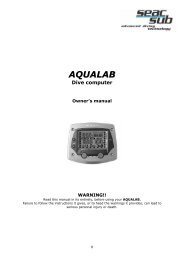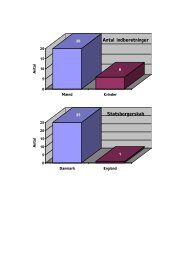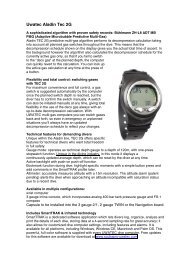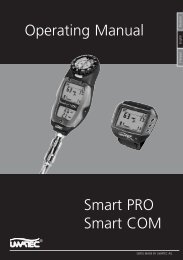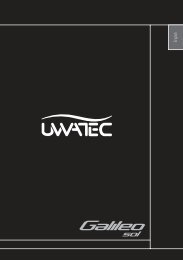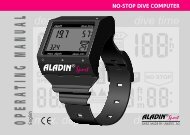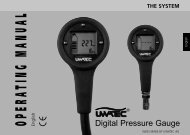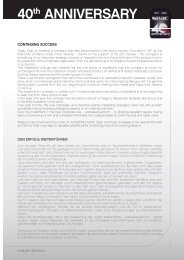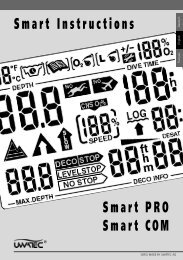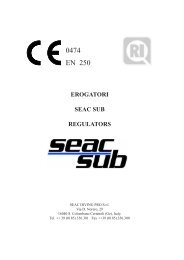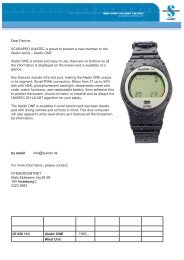Create successful ePaper yourself
Turn your PDF publications into a flip-book with our unique Google optimized e-Paper software.
safety on the move<br />
Keep your cylinder in top condition by following these<br />
common-sense guidelines:<br />
! Always secure your cylinder safely when in transit -<br />
a dry wooden box or sturdy cardboard container is ideal<br />
! Prevent the cylinder from rolling about - any impact<br />
could damage the shell by indenting, scratching,<br />
gouging, scoring or chipping off protective paint finishes<br />
! Do NOT throw the cylinder onto sand or ground - it<br />
may impact against a hidden hard object that could<br />
cause damage<br />
! Take care to avoid dropping your cylinder -<br />
as well as damaging an empty cylinder,<br />
dropping a charged cylinder could shear<br />
the valve<br />
! Prevent the cylinder from being exposed<br />
to direct sunlight or where the sun is<br />
directed through windows or clear glass<br />
roofing.<br />
Keep your cylinder cool. Filled cylinders that<br />
become warm (up to 60˚C) could result in<br />
breathing difficulties due to the temperature<br />
of the contained gas. Never expose your<br />
cylinder to temperatures in excess of 60˚C.<br />
care andmaintenance of your new cylinder<br />
importantmarkings<br />
cleaning and storage<br />
!<br />
!<br />
!<br />
!<br />
!<br />
After use, thoroughly wash the outside and boot<br />
assembly with clean water containing mild<br />
soap or detergent, rinse off and wipe<br />
dry with a towel.<br />
It is advisable to remove the cylinder<br />
from its backpack and the boot for<br />
regular cleaning<br />
Keep the threads and cylinder interior<br />
dry and free from contamination of any sort<br />
ALWAYS ensure your cylinder maintains a slight positive<br />
pressure up to 20 bar<br />
NEVER store the cylinder on bare concrete or any surface<br />
that may hold moisture<br />
Cylinders used as part of a bouyancy aid must be washed<br />
in fresh water and thoroughly dried after each use.<br />
Your life depends on your<br />
cylinder so always treat it with<br />
care and respect!<br />
testing check list<br />
!<br />
!<br />
ALWAYS ensure your cylinder is re-tested within the<br />
prescribed period for the UK and EEC (BSEN1802:2002)<br />
ALWAYS ensure that the cylinder attachments are<br />
maintained, serviced, inspected and handled in strict<br />
accordance with the manufacturers instructions.<br />
repair<br />
!<br />
!<br />
!<br />
!<br />
If the painted surface is damaged do not ignore it!<br />
Clean the area with fine wire wool and touch up the<br />
damage with a room-temperature air-drying aluminium<br />
primer followed by a room temperature drying gloss paint.<br />
Do not use paints with a curing temperature above<br />
ambient. For further information contact the manufacturer<br />
Do not attempt to remove a damaged paint surface<br />
with abrasive wheels, files, shot-blasting or aggressive<br />
chemicals. This may reduce the wall thickness making<br />
the cylinder unsafe for pressure storage<br />
Do not leave valves open after use. This allows<br />
moist-air intake that can cause internal corrosion<br />
If using stainless steel fixtures as a backpack clamp - coat<br />
with a suitable plastic to insulate from the aluminium.<br />
warning!<br />
!<br />
!<br />
Date<br />
Purchased<br />
Purchased<br />
From<br />
Cylinder<br />
Serial No<br />
Cylinder<br />
Capacity<br />
Charged<br />
Pressure<br />
Test<br />
Pressure<br />
Original<br />
Test Date<br />
Thread<br />
Size<br />
NEVER alter or obscure the cylinder markings!<br />
NEVER fill or partially fill your cylinder with Oxygen,<br />
Oxygen mixtures or Nitrox unless the cylinder and<br />
valve have been properly cleaned and maintained<br />
for these mixtures!<br />
Please fill out the details below and<br />
keep as a reference when re-testing<br />
or filling your cylinder.<br />
Distributed by:<br />
This leaflet is a general <strong>Guide</strong> to the use &<br />
care of your <strong>Luxfer</strong> Scuba Cylinder. If you have<br />
bought this cylinder as a single item only (ie.<br />
no valve fitted), you must also refer to <strong>Luxfer</strong>’s<br />
PED Customer Information Sheet. If you bought<br />
this cylinder as part of a Scuba equipment<br />
assembly (ie. valve fitted etc.) you must also<br />
refer to the equipment assemblers<br />
PED Customer Information Sheet.<br />
<strong>Luxfer</strong> Gas Cylinders, Colwick, Nottingham, NG4 2BH, UK. www.luxfercylinders.com<br />
© <strong>Luxfer</strong> 2002<br />
The markings stamped on the neck<br />
of your cylinder contain important<br />
information which should be referred to<br />
when re-testing or filling.<br />
1<br />
6<br />
2 3 4<br />
7<br />
11<br />
8<br />
12<br />
9<br />
14<br />
13<br />
5<br />
10<br />
Thread Specification<br />
1<br />
indicates the cylinder<br />
thread type and size. It is<br />
important to ensure the correct<br />
valve is used with your cylinder<br />
2<br />
3<br />
Country of Manufacture<br />
Cylinder Manufacturer<br />
4 Cylinder Type Number<br />
and Serial Number<br />
this number is recorded by<br />
<strong>Luxfer</strong> so that the entire<br />
manufacturing history of your<br />
cylinder can be traced<br />
5<br />
6<br />
7<br />
8<br />
Alloy of Construction<br />
Design Minimum Wall<br />
Thickness<br />
Empty Weight of<br />
Cylinder Only (kg)<br />
Minimum Water<br />
Capacity (litres)<br />
9 Working Pressure<br />
shows the pressure that<br />
the cylinder should be filled to.<br />
NOT to be exceeded<br />
Test Pressure<br />
10<br />
shows the pressure that<br />
the cylinder should be tested to.<br />
NOT to be exceeded<br />
11 Service Pressure<br />
indicates the pressure<br />
which can develop inside the<br />
cylinder at the temperature<br />
shown. It should NOT to be<br />
confused with the working<br />
pressure (PW)<br />
12 Mark of Conformity<br />
to the Pressure Equipment<br />
Directive 97/23/EC & Notified<br />
Body Identification Number<br />
13<br />
Test Date<br />
shows when your cylinder<br />
was first tested, with the year<br />
followed by the month or quarter<br />
of the test year shown in a circle<br />
Customer/Trade Name<br />
14<br />
(on reverse of cylinder)<br />
for whom the cylinder was<br />
originally made (optional).



